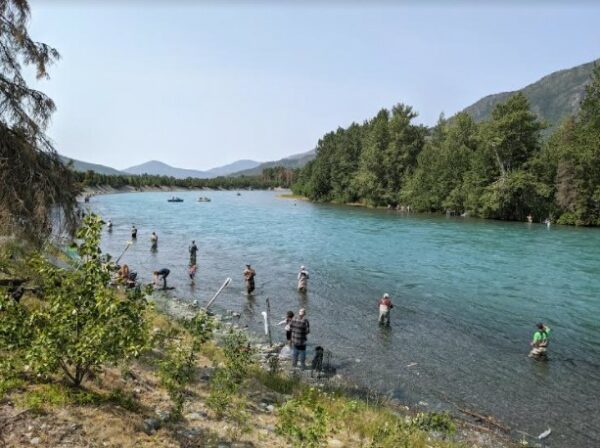
The Kenai River will close entirely to king salmon fishing starting Wednesday.
The Alaska Department of Fish and Game announced the closure Monday afternoon after nearly three weeks of watching the late-run king salmon fail to return to the Kenai River in large enough numbers.
The lower river started July with a king fishery open to retention, but no bait allowed: The department moved to catch-and-release only, with a note further action might be necessary. But even with the fishery closed, biologists don’t think the run will make the minimum escapement goal.
Only 2,872 large kings have passed the sonar on the Kenai River since July 1. Fish and Game only counts large kings, which are kings longer than 75 centimeters from mid-eye to tail fork, for escapement. The minimum escapement is 15,000, and Fish and Game is currently projecting about 10,000 fish to return, according to the emergency order issued Monday.
The closure affects both the sport fishery in the river and the commercial fishery. By regulation, when the sport fishery for king salmon is closed in the Kenai, the setnet fisheries on Cook Inlet’s east side are completely closed. Brian Marston, commercial area management biologist for Upper Cook Inlet, said no more openings will be planned for setnetters this season unless something changes.
“As per the Kenai River Late Run king salmon management plan, no other commercial set gillnet openings in the Upper Subdistrict of the Central District will occur after Tuesday, July 20, unless the Kenai River late run king salmon abundance improves,” Marston said in his commercial fisheries announcement Monday.
Setnetters have long argued the paired restrictions are unfair to them — while guides and sport fishermen can continue to fish for other species, they are shut down.
Andy Hall, who is the president of setnetter organization Kenai Peninsula Fishermen’s Association, says nobody is happy about the kings not coming back to the Kenai River, but setnetters are particularly disproportionately affected.
To prevent fishermen moving elsewhere to get kings, Fish and Game also closed king salmon fishing in the Kasilof River and the Cook Inlet saltwater from Bluff Point north. The personal-use dipnet fishery remains open, but only for other species — they can’t keep kings, either.
So far, Cook Inlet’s commercial fishermen have harvested about 589,000 salmon total, most of which are sockeye. With all the setnets taken out of the water and the drift fleet reined in, that harvest number is likely to stagnate as the run moves toward August.
Over the last few years, more and more of the run has been arriving in the river in August, after most of the commercial fisheries are closed by regulation.
Last year, commercial fishermen landed about 670,000 sockeye in Upper Cook Inlet, worth about $4.2 million. It was the second-smallest sockeye catch on record for the region, but the total ex-vessel value of the fishery was the lowest on record, according to Fish and Game.
As of Sunday, 214,000 sockeye had passed the sonar in the Kenai River, with a projected final escapement of between 790,000 and 1.4 million sockeye. The Kasilof sonar has counted about 250,000 sockeye, and projects final escapement of about 476,000 sockeye. The online fish counts page on Fish and Game’s website is currently unavailable to the public.
Reach Elizabeth Earl at elizabethearl@gmail.com.




